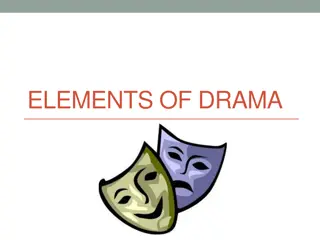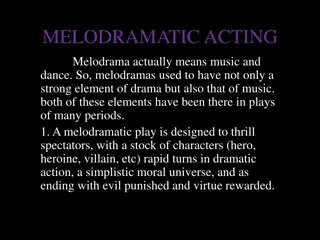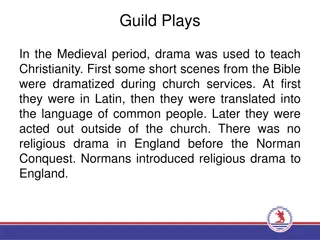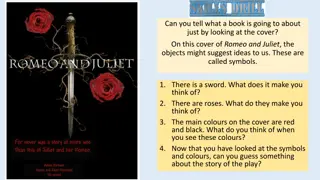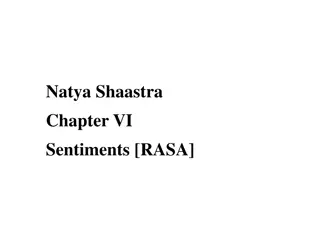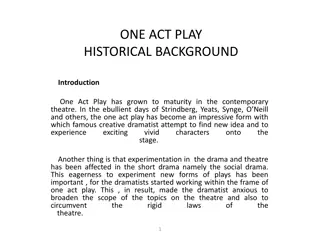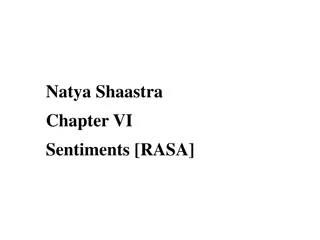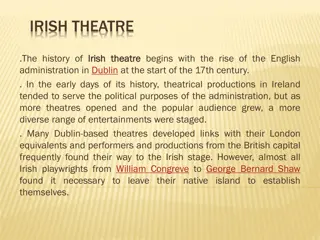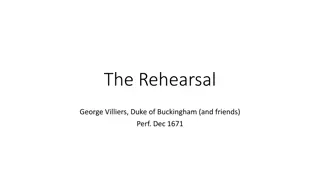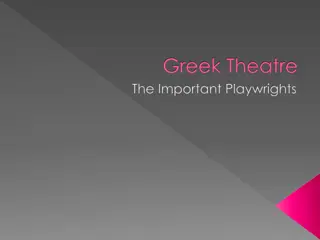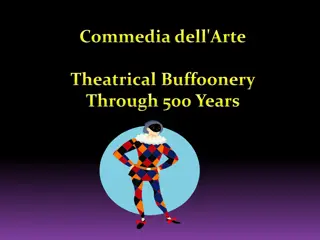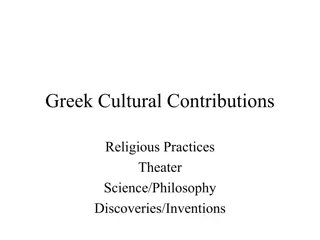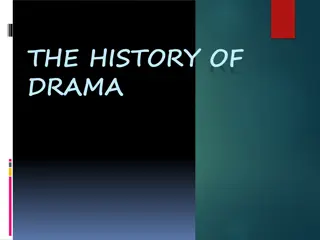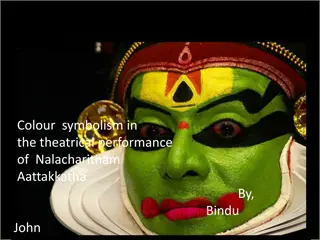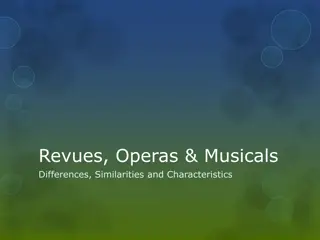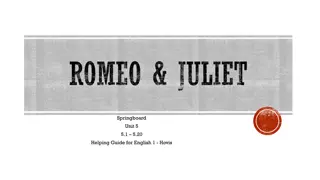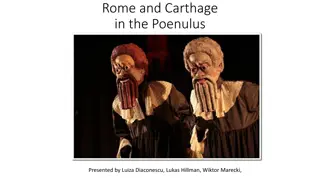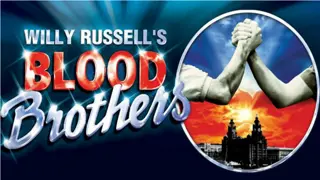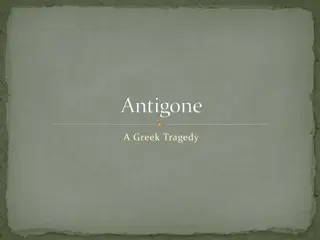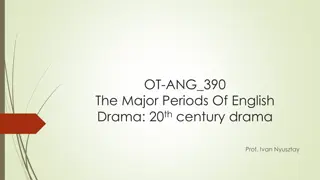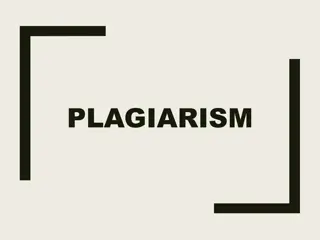Understanding the Elements of Drama and Theater History
Drama, originating from the Greek verb "dran," involves acting and storytelling in front of an audience. Explore the key aspects, from the Globe Theater in London to dramatic structure, actors, and speech forms like dialogue and monologue. Learn about the crucial components such as playwrights, acto
4 views • 22 slides
Exploring Performance and Storytelling in 'Hag-Seed' Prologue
In the prologue of "Hag-Seed" by Margaret Atwood, the performative nature of storytelling is vividly portrayed through the setting of a theatrical performance within the novel. Atwood intertwines themes of reimagining existing stories, life as a performance, and the connection to Shakespeare's works
1 views • 6 slides
If you are looking for Venue Selection in The Lakes
If you are looking for Venue Selection in The Lakes, Dusk Till Dawn Entertainment is leading turnkey event solutions provider in Las Vegas. With almost two decades of experience in the industry, we have taken care of all the groundwork, so you don't have to. From corporate gatherings to private affa
0 views • 6 slides
Understanding Melodramatic Acting in Theatre
Melodramatic acting in theatre combines elements of drama, music, and spectacle to create thrilling performances for audiences. These plays feature stock characters, rapid dramatic action, and a simplistic moral universe where good triumphs over evil. Actors in melodramas must master melodramatic sp
0 views • 7 slides
Medieval Drama: Guild Plays and Moral Lessons
Learn about the evolution of medieval drama in England, from religious guild plays to morality plays and interludes. Guild plays, including mystery and miracle plays, were performed by craft guilds to teach Christianity through biblical stories. Morality plays like "Everyman" aimed to impart moral l
3 views • 9 slides
Symbols and Facts: Uncovering Shakespeare and Elizabethan Theatre
The analysis begins by exploring the symbols present on the cover of "Romeo and Juliet" such as the sword and roses. It then delves into distinguishing facts from opinions regarding Shakespeare's life, touching on key events like his baptism, marriage, and career. Additionally, it provides insights
0 views • 26 slides
Ancient Indian Theatrical Art Forms and the Theory of Rasa in Natya Shastra
The Natya Shastra, attributed to Bharata Muni, is an ancient treatise influencing Indian dance, music, and literary traditions. This comprehensive work covers various aspects of theatre, including acting, dance, music, and more. The concept of Rasa, denoting the aesthetic essence that evokes emotion
0 views • 18 slides
Evolution of One-Act Plays in Contemporary Theatre
One-Act Plays have evolved significantly in contemporary theatre, with famous dramatists like Strindberg, Yeats, and Synge experimenting with this concise form. Initially farcical, one-act plays became more focused, dealing with single dominant situations and themes like human life's complexities. T
0 views • 5 slides
Devising Drama - GCSE Knowledge Organiser
This GCSE Drama Knowledge Organiser provides guidance on devising and performing an original piece of theatre based on a stimulus. It covers how to respond to stimuli, develop ideas for theatrical performances, apply theatrical skills, analyze and evaluate work, and rehearse and refine the devised p
0 views • 10 slides
Exploring the Rasa Theory in Natya Shastra: An Ancient Guide to Indian Theatrical Arts
The Natya Shastra, attributed to Bharata Muni, is a comprehensive treatise on the arts that has shaped Indian dance, music, and literary traditions. This ancient text delves into various aspects of theatre, such as acting, dance, music, and construction, providing a foundation for Indian theatrical
3 views • 18 slides
Exploring Restoration Drama and Prose in the Era of Charles II
In 1660, with Charles II's ascent to the throne, Restoration literature saw a revival alongside the political landscape. Playwrights like John Dryden and Thomas Otway contributed significant works, with genres ranging from heroic plays to satirical comedies. The era also witnessed the emergence of t
1 views • 12 slides
History and Evolution of Irish Theatre
Irish theatre has a rich history intertwined with politics and cultural developments. From serving political purposes in the 17th century to nurturing indigenous writers and performers in the 20th century, Irish theatre has seen significant evolution. Dublin has been a key hub for theatrical product
0 views • 24 slides
The Rehearsal and The Antagonists: Satire in Restoration Drama
The Duke of Buckingham's satirical play "The Rehearsal" marked a significant shift in Restoration drama by mocking contemporary heroic plays and literary figures like John Dryden. The play, first performed in 1671, achieved popularity and influenced a tradition of dramatic burlesque on the English s
1 views • 8 slides
Evaluating the Production Elements: Set Design, Props, Costume, Lighting, Sound, Special Effects, Acting & Directing
Use the guide slides to assess various production elements including set design, props, costume, lighting, sound, special effects, acting, and directing. Explore examples from scenes like Peter Pan teaching children to fly, impactful moments, successful elements, and set design descriptions. Gain in
1 views • 7 slides
Understanding Drama Form and Genre
Exploring the nuances of drama, this content delves into the intricate relationship between form and genre. Offering insights into the varied types of forms in drama such as scripted plays, physical theatre, mime, monologues, movement/dance dramas, musicals, and pantomimes, it emphasizes the flexibi
0 views • 17 slides
Insights into Greek Theatre's Renowned Playwrights and Dramatic Elements
Greek theatre history and key figures, including important playwrights like Aeschylus, Sophocles, and Euripides. Aristotle's theories on drama elements, Thespis' innovations, and Aristotle's Unities of Drama are explored. The impact of these elements and playwrights on ancient Greek theatre is highl
7 views • 9 slides
Insights into Italian Commedia dell'arte Traditions
A discussion on the unique characteristics of Italian commedia dell'arte, encompassing the challenges of dialects, minimalist staging with creative prop use, the art of improvisation, stock characters, and the iconic figure of Arlecchino. The performers' ability to improvise, employ comedic elements
4 views • 21 slides
Greek Cultural Contributions: From Olympics to Theater
Ancient Greek civilization made significant cultural contributions in various aspects such as religious practices, theater, and scientific discoveries. The Greeks had a rich tradition of honoring their gods through events like the Olympics and theatrical performances that continue to fascinate audie
4 views • 26 slides
Exploring Plastic Theatre in Tennessee Williams' "A Streetcar Named Desire
Tennessee Williams introduced the concept of plastic theatre in the 1940s to create a new type of theatrical experience that combined non-literary elements with the literary text. This approach aimed to enhance the themes, characters, and language of the play by integrating elements such as setting,
0 views • 9 slides
The Evolution of Drama: A Historical Journey
Drama, originating from ancient Greece, has evolved through the centuries from being a genre of poetry to a distinct theatrical form encompassing tragedy, comedy, and more. The masks of Thalia and Melpomene symbolize the essence of comedy and tragedy, while the Great Dionysia festival in Athens hono
0 views • 41 slides
Designing a Key Scene for Stage Types: In the Round and Proscenium Arch
Exploring the design considerations for key scenes on two different stage types, In the Round and Proscenium Arch. The strengths and weaknesses for performers and audience members are analyzed, offering insights into creating engaging and effective theatrical experiences.
0 views • 27 slides
Exploring Colour Symbolism in the Theatrical Performance of Nalacharitham Aattakkatha John Bindu
Delve into the captivating world of colour symbolism in the theatrical performance of Nalacharitham Aattakkatha John Bindu, where hues convey deeper meanings and emotions. Discover how colours like Pacha, Minukku, Karuthathadi, and more play a vital role in portraying characters and themes, enhancin
0 views • 13 slides
Protecting Older Adults from Scams Through Educational Theatre
This initiative titled "Hello Granny I Need Money" aims to protect seniors from scams by false grandchildren and other fraudsters through educational theatre performances. Developed in Stuttgart, Germany, since 2011, this project has seen significant success with multiple performances and partnershi
0 views • 23 slides
A Comparative Analysis of Revues, Operas, and Musicals
Revues, operas, and musicals each exhibit unique characteristics while sharing elements of song, dance, and entertainment. Revues feature a variety of acts with no central plot, operas emphasize music and singing with distinct types like operettas and grand operas, and musicals blend music, dance, a
0 views • 21 slides
Romeo & Juliet Springboard Unit Study Guide Activities
Explore various activities related to the study of Romeo and Juliet, including analyzing themes, character motivations, and theatrical elements. Engage in discussions, inferencing exercises, and opinion-based responses to deepen understanding of the play.
2 views • 17 slides
Interactions and Complexity in "Rome and Carthage in the Poenulus
Rome and Carthage clash in the play Poenulus, with characters like Hanno, Agorastocles, and Milphio adding depth to the narrative. The dynamics between Roman and Carthaginian cultures, the complexity of nationality and characterization, and the subversion of audience expectations through intricate r
0 views • 11 slides
Drama Between the Wars: Evolution of American Theater
Exploring the evolution of American drama between the wars, from the Puritan rejection of theater to the emergence of American playwrights and the influence of European masters. The rise of popular forms like vaudeville and the impact of theatrical companies post-WWI, with a focus on key figures lik
0 views • 10 slides
Exploration of Faith, Love, and Identity in Chris Goode's Works
Chris Goode's theatrical works delve into themes of spiritual turmoil, crisis of faith, and unconventional relationships. From "God/Head" questioning the existence of God to "Wound Man and Shirley" portraying a unique love story with Wound Man as an unconventional superhero, Goode's performances cap
0 views • 8 slides
Exploring Character Choices in Blood Brothers Play
Dive into the character choices made by directors in presenting Mickey and Edward on stage in the play "Blood Brothers." Consider the physical appearance, interactions, and context in which these characters are portrayed, shedding light on the nuances of characterisation in theatrical performances.
0 views • 7 slides
Elizabethan Theatre Concerns and Metatheatre Reflections
The Elizabethan era was marked by concerns about the moral influence of theatres. This period saw the establishment of new buildings like The Theatre and The Curtain. Philip Stubbes criticized the theatregoers' behavior, highlighting perceived vices portrayed in plays. Similarly, Sir Philip Sidney d
0 views • 40 slides
The Art of Georgian Acting: 1714-1830
Delve into the world of Georgian acting from 1714 to 1830 through the eyes of insightful texts and practical illustrations. Explore the nuances of rhetorical gesture, mimic expression, and theatrical eloquence as described by prominent figures in acting history. Uncover the blend of articulation, co
0 views • 17 slides
Understanding Rasa Theory in Indian Theatrical Arts
Explore the significance of Rasa theory in Indian theatrical arts as outlined in the Natya Shastra, an ancient treatise on performing arts. Discover how bhavas create rasas, evoking emotions in the audience and transporting them to a parallel world of wonder and reflection. Learn about the historica
0 views • 18 slides
Mrs. Simpson's English 9 Course Overview
Explore Mrs. Simpson's English 9 course covering essential topics like Coming of Age, Style Analysis, and To Kill a Mockingbird. Students will delve into writing argumentative essays, analyzing cinematic styles, and researching historical contexts. The course culminates in a study of theatrical elem
0 views • 7 slides
Exploring Medieval Cycle Plays and Mystery Drama Traditions
Dive into the world of Medieval Cycle Plays, including Mystery Plays, Passion Plays, and the Guilds that sponsored these performances. Discover the origins, significance, and cultural impact of these historical theatrical traditions, from Mystery Play Guilds to the iconic Oberammergau Passion Play.
0 views • 8 slides
Exploring Dramatherapy: A Tool for Psychological Growth
Dramatherapy is a holistic approach that uses drama and theatrical techniques to facilitate psychological growth and change. It draws from various disciplines like psychology, theatre, and anthropology to help individuals explore and resolve inner conflicts, express unresolved issues, and develop em
0 views • 47 slides
Understanding the Elements of Greek Tragedy
Delve into the key components of Greek tragedy, exploring the characteristics of a tragic hero, the concept of tragic flaw (Hamartia), classic moments in the tragic plot, Aristotle's definition of tragedy, and the dramatic unities in a play. Discover the structure of a tragedy, from the prologue to
0 views • 19 slides
Exploring the Evolution of English Drama in the 20th Century
In the realm of English drama in the 20th century, significant periods such as Modern British Drama, Naturalism, and the works of George Bernard Shaw shaped the theatrical landscape. From the rejection of past ideals to the emergence of new social commentary, playwrights like Shaw and Ibsen challeng
0 views • 39 slides
Exploring the Art of Lighting Design in Technical Theatre
Delve into the world of lighting design in technical theatre, where light directs audience focus, shapes mood, and enhances the theatrical experience. Discover the functions of stage light, precautions for performer safety, and how elements work together to realize the director's vision. Dive into s
0 views • 35 slides
Exploring Stage Types in Shakespeare's Globe Theatre
The Globe Theater, where many of Shakespeare's plays were first performed, offered a unique experience to audiences. Learn about the different stage types such as Proscenium Arch, Open Thrust, and In-the-Round, each providing a distinct setting for theatrical productions.
0 views • 5 slides
Uncovering Theatrical Depths in Hamlet's Characterization
Unveiling the theatrical intricacies within Hamlet's character, this piece delves into the subtext of his actions and the underlying motives behind his feigned madness and calculated interactions, as depicted in A. Kernan's work "The Playwright as Magician". Through a close analysis of pivotal scene
0 views • 31 slides
